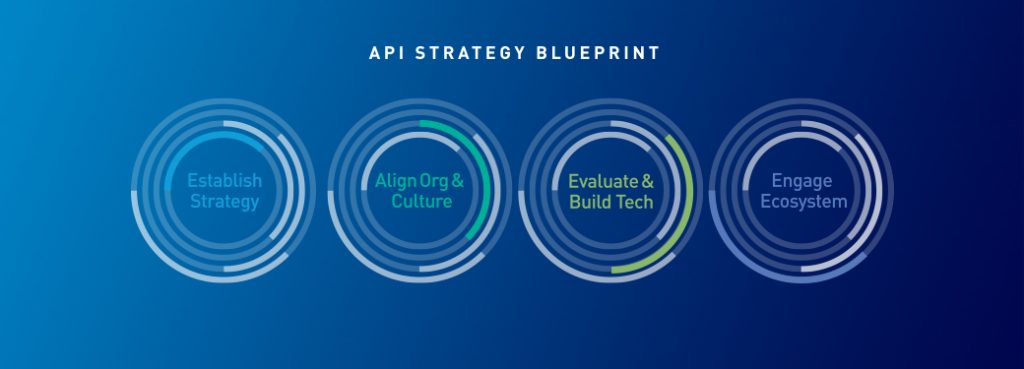In preparing for digital transformation, companies usually pass through several stages. The first is coming to grips with the true scope of the undertaking that lies ahead. The second is understanding the role that APIs will play. The third and the subject of this article is executing an API program.

API programs are cross-organizational change initiatives that allow companies to maximize the benefits of carrying out a digital transformation with the assistance of APIs. Whether the changes are impacting a group of teams, the entire enterprise, or a collection of companies, such as an industry consortium, it is worth pursuing an API program in order to make sure your API execution efforts align with your organization’s digital strategy, to ensure participation in the broader API ecosystem, and to provide visibility, communication, and education across the enterprise.
The purpose of this article is to share lessons MuleSoft has learned while helping companies implement hundreds of API programs, to highlight some potential pitfalls, and to provide a path for navigating around them. All these lessons are reflected in the API strategy blueprint, which identifies the four focus areas that are core to using an API program to achieve digital transformation goals. Finally, we’ll look at how IQVIA is applying the blueprint to support innovation in the health sciences.
Keep business goals in sight
Technology initiatives tend to be focused on technology. It is natural for the leaders of an API program to define the goal as the delivery of a bunch of APIs. But placing too much emphasis on software can obscure the bigger picture. APIs are not the end game. It is important to continually be moving toward the business goal posts. You want to always keep in mind the broader set of objectives.
At the same time, attempting to achieve a far-reaching vision of digital transformation through a multipronged push can also undermine your success. Once a company commits to using digital mechanisms in every way it can, it can be tempting to jump into implementing your API program with both feet.
The thing to remember is that software development is not the hardest part of a technology-driven change initiative. Anyone who has tried to introduce a new way of doing things into a company culture knows that the biggest enemy is not the naysayers. The biggest enemy is the people who nod their heads and say, “Yes, we need to change,” and then they don’t.
Four approaches can be helpful in overcoming resistance. Borrowing from the school of lean software: start small, iterate and get quick wins. Build in incentives wherever possible. Slice vertically instead of horizontally—i.e. go end-to-end on a particular business area or API. Far less effective is to decide that the first step is to implement one aspect of your API program everywhere. The problem with this is you are not delivering an end state, and you are also not achieving anything of tangible benefit to the business.
The API strategy blueprint
In assessing the best practices of executing an API strategy through an API program, MuleSoft combined years of engagement with more than 1,600 enterprise customers with ProgrammableWeb’s experience chronicling the successes and failures of the API economy. The result is our API strategy blueprint, which consists of four focus areas. This blueprint provides a structure that shows how APIs can help address the interconnected stages of digital transformation. We start with a digital strategy that is driven by a comprehensive understanding of the current state of a business. Once you determine where you are and where you want to go, you can set goals and principles and begin reimagining the customer experience.
The second focus area is organization and culture. You want to structure your organization so that it is optimized for delivering digital products. Leaders of the API economy follow new production paradigms that include Agile development practices, a DevOps mentality, cloud-native technologies, etc. But adopting the “way of the API” often requires a major cultural shift. Embedding principles, incentivizing self-governance, encouraging experimentation and learning can all help to overcome resistance.
Once your digital strategy is aligned with organizational practices, culture, and methodologies, it’s time to turn your attention to technology. You want to make sure you’re investing in the capabilities you need to achieve your business goals. And, along with the technologies that open up your business and support new customer experiences, you will need counterbalancing controls that ensure high levels of security, privacy, availability, and performance.
The fourth focus area is engaging the ecosystem. First and foremost this means the developers who will be the primary users of your APIs, as well as your most effective evangelists and insightful product designers. But it also means collaborating with partners who have existing APIs or co-developed APIs that support or enhance your organization’s digital products. As you build on the digital products released by your partners or your partners build on your digital products, the multiplication of value that has come to characterize the API economy kicks in.
While breaking down an API program into these four focus areas can be enormously helpful in terms of successful execution, keep in mind that they are interrelated. As you implement your API program, you will find yourself revisiting focus areas as you iterate and improve with each new release.
IQVIA becomes a platform of platforms driven by APIs
In global health care, there is no more valuable resource than data. And in 2017, IQVIA, a company newly formed from the merger of Quintiles and IMS Health, found itself sitting on a gold mine. They were the biggest contract research firm in the world with more than 5 billion unidentified patient records and more than 20 petabytes of unique data. But they were also a large, mature company, made up of disparate parts, with more than 55,000 employees around the world in an industry that was undergoing digital disruption.
To focus their digital strategy, IQVIA took an in-depth, introspective look at their business and came up with a clear vision aligned with their identity as a healthcare company, a services company, and a data company in one. IQVIA’s data allowed it to capture the entire lifespan of a drug, from molecule to market. Around the world, this data guided mission-critical business decisions. If IQVIA could make the data more available to customers, it could be a game changer.
After surveying the capabilities IQVIA currently possessed and the capabilities they needed, they began investing. Before long, their growing product portfolio created integration challenges. The leadership team decided they would become a platform of platforms with everything driven by APIs. They parsed out the technologies they felt were differentiators from the technologies that were industry standard, like CRM or file sharing.
IQVIA’s API program focused on the creation of a company-spanning API layer, known as Lexi, that connected all applications and data using a common vocabulary and powered an integration platform as a service solution. In addition to reducing the costs and complexities of integration, Lexi facilitated a seamless customer experience and became a launch point for new products and services that met the specific needs of an ecosystem of users.
Not all API programs are as ambitious as IQVIA’s. But all successful programs will pass through the same stages—establishing a strategy; aligning the organizational structure, culture, and methodologies; evaluating and building supporting technology; and engaging the ecosystem.









